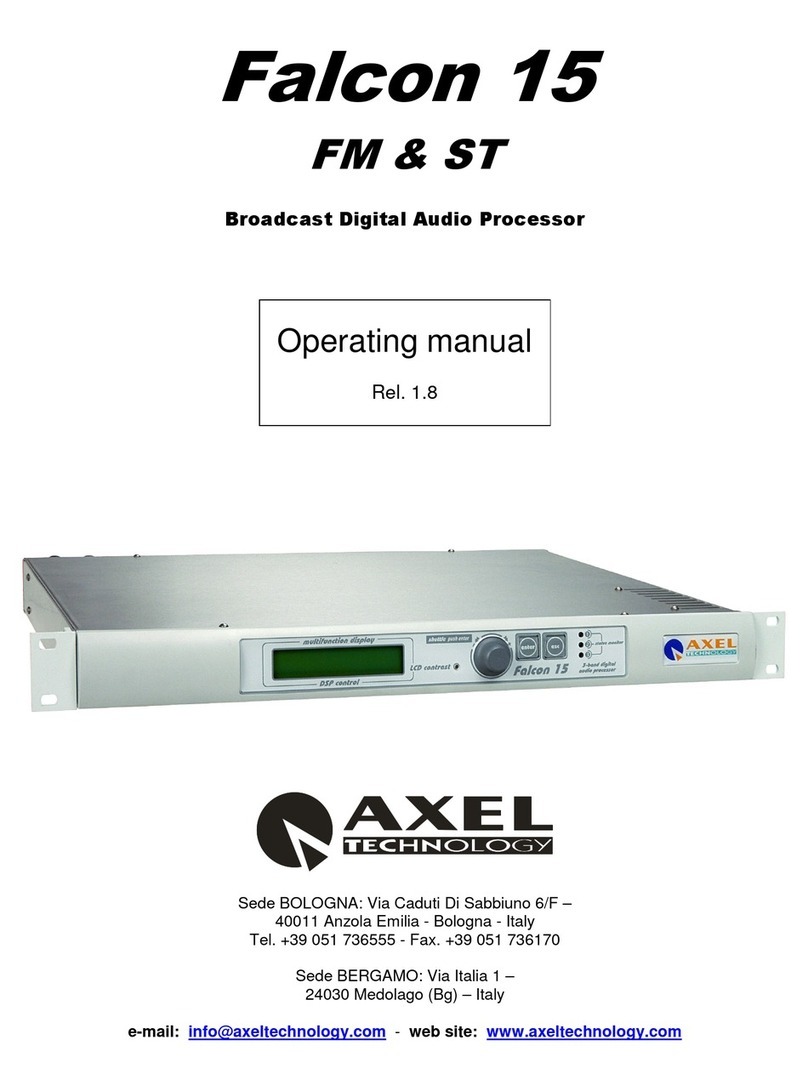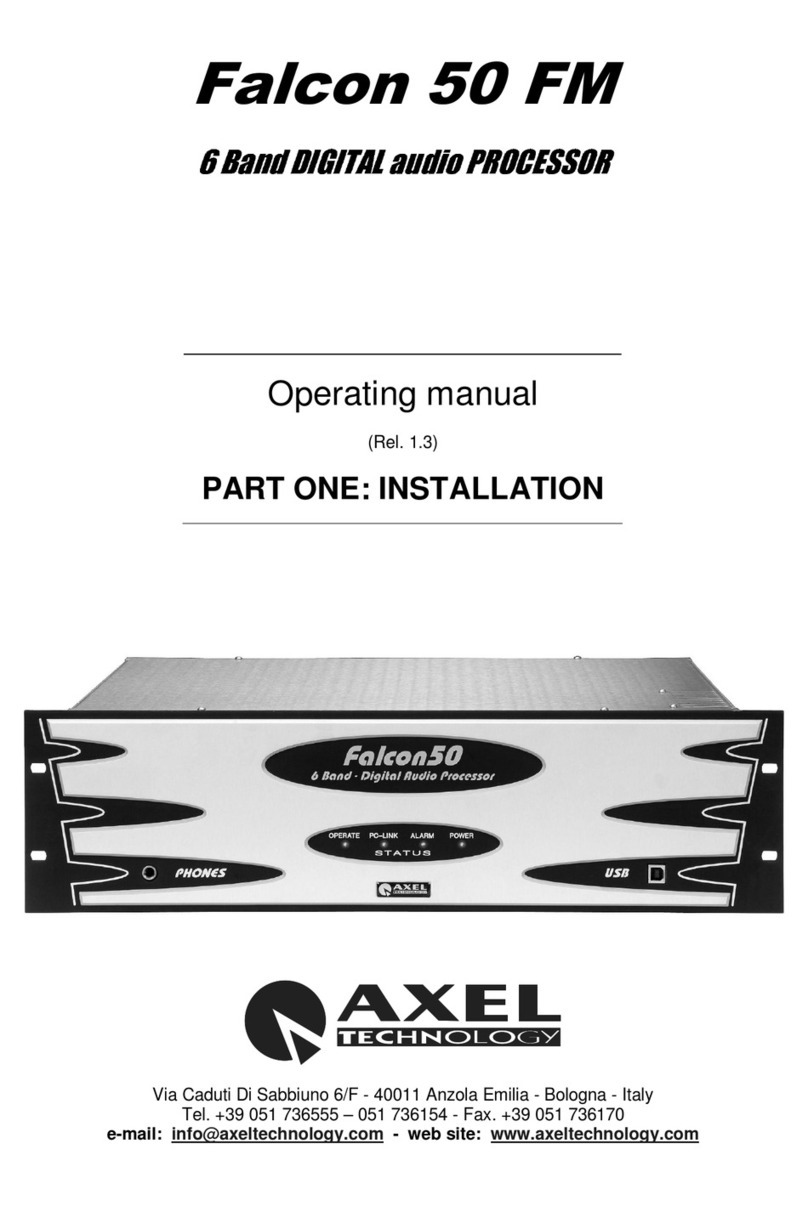TABLE OF CONTENTS
Page 4
22.4 FLOOR AGC...................................................................................................................................................... 43
22.5 WORK AGC ...................................................................................................................................................... 43
22.6 MAX GAIN......................................................................................................................................................... 43
22.7 DEFAULT VALUES FOR AGC –TV VERSION........................................................................................... 43
23 SETUP OF DISCRETE (L & R) AUDIO OUTPUT................................................................................44
23.1 ANALOG OUTPUT LEVEL ...........................................................................................................................44
23.2 DIGITAL AUDIO OUTPUT LEVEL .............................................................................................................. 44
23.3 NOISE GATE SETTING (NOISE GATE) .......................................................................................................... 44
23.4 ANALOG OUTPUT PRE-EMPHASIS............................................................................................................ 45
23.5 OUTPUT PRE-EMPHASIS FOR THE FM VERSION ONLY: .......................................................................... 45
23.6 DIGITAL AUDIO OUTPUT PRE-EMPHASIS (ST VERSION ONLY)............................................................... 46
23.7 CHANGING THE OPERATING MODE (OUTPUT MODE)............................................................................... 46
23.8 POWER LIMITER CONTROL ITU 412 (ST VERSION ONLY) ......................................................................... 46
24 SETUP OF WEB OUTPUT on the ‘ST’ version..................................................................................48
25 SETUP OF MPX OUTPUT (FM version only).....................................................................................49
25.1 MPX OUTPUT LEVEL*.................................................................................................................................. 49
25.2 MPX OUTPUT PREEMPHASIS (FM VERSION ONLY)*.................................................................................. 50
25.3 PILOT CALIBRATION (FM VERSION ONLY)*............................................................................................... 50
25.4 RDS SIGNAL LEVEL CONTROL (FM VERSION ONLY)***.......................................................................... 51
26 ADDITIONAL SETUP TASKS..............................................................................................................52
26.1 SERIAL PORT ENABLING (SERIAL MODULE).............................................................................................. 52
26.2 STEREO ENHANCEMENT SETTING (STRENHMODULE) .......................................................................... 52
26.3 READING OUT THEFIRMWARE CODE .......................................................................................................... 53
26.4 READING OUT THEINTERNAL TEMPERATURE.......................................................................................... 53
26.5 READING OUT THEFIRMWARE VERSION...................................................................................................... 53
27 CHOOSING THE PROCESSING CURVE (all versions) ....................................................................54
27.1 INTRODUCTION............................................................................................................................................ 54
27.2 HEAVILY SPOKEN PROGRAMS ................................................................................................................. 54
27.3 HEAVILY MUSICAL PROGRAMS............................................................................................................... 54
27.4 CREATING ANEW CURVE VIA THE MENU ............................................................................................. 55
28 THE PC CONTROL SOFTWARE (FM , ST/WEB, TV versions) ........................................................58
28.1 INTRODUCTION............................................................................................................................................ 58
28.2 BIDIRECTIONAL MODE (DIRECT CONTROL).......................................................................................... 58
28.3 MONO-DIRECTIONAL MODE (REMOTE).................................................................................................. 59
28.4 INSTALLATION............................................................................................................................................. 60
28.5 SOFTWARE SETUP........................................................................................................................................ 61
28.6 LOAD, SAVE AND RESTORE FUNCTIONS................................................................................................ 62
28.7 LOADING AN EXISTING CONFIGURATION............................................................................................. 62
28.8 SAVING THE CURRENT CONFIGURATION.............................................................................................. 62
28.9 THE ‘RESTORE’ FUNCTION ........................................................................................................................63
28.10 BI-DIRECTIONAL CONNECTION MODE............................................................................................... 64
28.11 THE ‘TARGET NAME AND GROUP NAME’ IDENTIFIERS.................................................................. 65
28.12 PROCESSOR PANEL LOCK FUNCTION ................................................................................................. 65
28.13 UNIDIRECTIONAL CONNECTION MODE ............................................................................................. 66
29 USING THE RDS SECTION (FM version ONLY) ...............................................................................68
29.1 MAIN SCREEN ............................................................................................................................................... 68
29.2 RDS SERVICES -QUICK SUMMARY.......................................................................................................... 69
29.3 TAREMOTE CONTROL TROUGH OPTO INTERFACE............................................................................. 70
29.4 PS (PROGRAM SERVICE NAME)PANEL ........................................................................................................... 71
29.5 SINGLE PS OR PS SEQUENCES ................................................................................................................... 71
29.6 PS IN SCROLLING MODE............................................................................................................................. 72
29.7 HINTS AND TIPS ABOUT DYNAMIC PS MODE........................................................................................ 73
29.8 ALTERNATIVE FREQUENCIES LIST.......................................................................................................... 73
29.9 AF METHODS AAND B ................................................................................................................................ 74
29.10 HOW TOGET THE RDS OPTION AFTER PURCHASING THEEQUIPMENT...................................... 76
30 FIRMWARE UPGRADE PROCEDURE ...............................................................................................77
31 TECHNICAL SPECIFICATIONS - FM version....................................................................................81
32 TECHNICAL SPECIFICATIONS - ST / WEB version.........................................................................83
33 TECHNICAL SPECIFICATIONS – TV version....................................................................................85
34 WARRANTY .........................................................................................................................................86





























